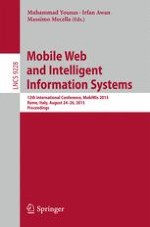2015 | Book
Mobile Web and Intelligent Information Systems
12th International Conference, MobiWis 2015, Rome, Italy, August 24-26, 2015, Proceedings
Editors: Muhammad Younas, Irfan Awan, Massimo Mecella
Publisher: Springer International Publishing
Book Series : Lecture Notes in Computer Science
